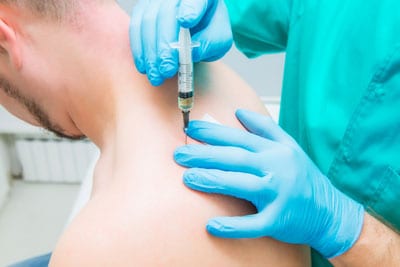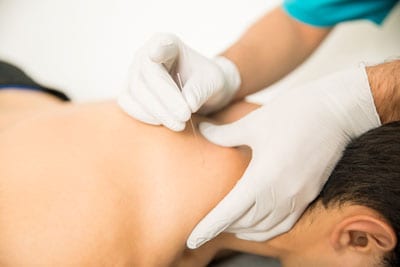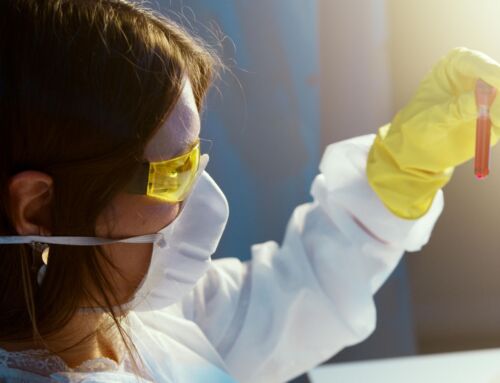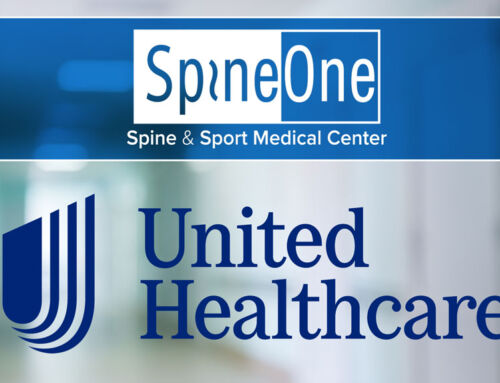Treating Knotted & Painful Muscles
What’s Better, Dry Needling or Trigger Point Injections?
When you feel a knot of pain on an injured, stiff, torn, or bruised muscle, the knot can be referred to as a “trigger point”. These trigger points are sensitive areas in the muscle or connective tissue (fascia) that causes pain when subjected to compression or pressure. Trigger points can cause pain to radiate throughout the muscle and fascia causing myofascial pain syndromes. Pain from an injured muscle can cause headaches and aches in other areas, such as the arms, legs, or lower back. Treating the pain at the trigger point is one of the most effective means of remedying these problems. If the pain does not respond to massage or nonsurgical treatment, your physical therapist or doctor may recommend either dry needling or a trigger point injection for treatment.
See a Doctor Today
What is a Trigger Point Injection?
A trigger point injection contains a mixture of medications that helps the muscle relax and reduce inflammation. This injection helps improve blood flow to let your body start to heal itself. Trigger point injections often contain lidocaine, Bupivacaine or a corticosteroid that may or may not be mixed with anesthetics.
Receiving a trigger point injection typically only takes 15 minutes. This procedure is very safe and there should not be any side effects. Trigger point injections have been shown to improve overall performance and efficiency when combined with physical therapy.


What is Dry Needling?
Dry needling is a variant of trigger point injection in which a fine needle is inserted into the skin and muscle at the site of myofascial pain. A thin needle penetrates the skin and treats underlying muscular trigger points. Dry needling’s goal is to reduce pain, calm trigger points and restore function. This procedure is often part of a broader physical therapy approach incorporating other traditional physical therapy interventions into treatment.
Dry Needling or Trigger Point Injections for Knotted Muscles?
Both of these treatments are effective at relieving muscle pain, especially in your arms, legs, lower back and neck. These treatments can also be used to treat fibromyalgia, tension headaches. and myofascial pain.
Dry needling is intended to stimulate the tissue and alter the signals between the brain and muscles, allowing a to return to a more normal movement pattern. The needles may need to stay inserted for a period of time ranging from 10 seconds to 10 minutes, depending on what type of pain is being treated and how long it has lasted.
Trigger point injections, on the other hand, use targeted medication to chemically coax the knotted muscle into releasing. This type of treatment is a more straightforward approach for those who may be anxious about the dry needling process and may be a more rapid therapy for patients dealing with extreme pain, or pain that hasn’t responded to other treatments.
The first step in learning which trigger point procedure is best for you is scheduling an appointment with a qualified physician. The physicians at SpineOne can diagnose the severity of your trigger point, help identify the root cause of the problem, and can suggest a treatment plan for long term pain relief. To schedule a same day evaluation with a SpineOne physician, call 303-367-2225, or contact us on our website.
More About Myofascial Pain
Myofascial pain syndrome affects your muscles and fascia. Your fascia is the thin connective tissue that is wrapped around every muscle. Fascia provides a slick surface so that individual muscle fibers, single muscles and muscle groups can slide against each other without creating friction, tearing or causing other problems.
Myofascial pain presents a pain and tenderness in your muscles. This pain and tenderness is often related to one or more trigger points. Myofascial pain and trigger points can develop in any muscle in the body, but the most commonly affected muscles are those in the upper back, shoulder and neck.


